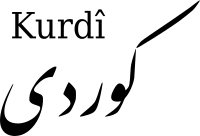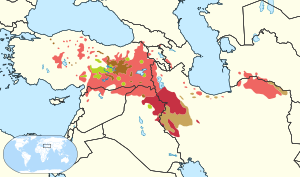Kurdish languages facts for kids
Quick facts for kids Kurdish |
||||
|---|---|---|---|---|
| Kurdî / کوردی | ||||
 |
||||
| Native to | Turkey, Iraq, Iran, Syria, Armenia, Azerbaijan | |||
| Region | Kurdistan, Anatolia, Caucasus, Khorasan, Kurdish diaspora | |||
| Ethnicity | Kurds | |||
| Native speakers | 25 million (2022) | |||
| Language family |
Indo-European
|
|||
| Dialects |
Northern Kurdish (Kurmanji)
Central Kurdish (Sorani)
Southern Kurdish (Xwarîn, Palewani)
Laki
|
|||
| Writing system | Hawar alphabet (Latin script; used mostly in Turkey and Syria) Sorani alphabet (Perso-Arabic script; used mostly in Iraq and Iran) Cyrillic alphabet (former Soviet Union) Armenian alphabet (1921-29 in Soviet Armenia) |
|||
| Official status | ||||
| Official language in | ||||
| Recognised minority language in | ||||
| Linguasphere | 58-AAA-a (North Kurdish incl. Kurmanji & Kurmanjiki) + 58-AAA-b (Central Kurdish incl. Dimli/Zaza & Gurani) + 58-AAA-c (South Kurdish incl. Kurdi) | |||

|
||||
|
||||
Kurdish (Kurdî, کوردی) is a language spoken by the Kurds people. They live in a region called Kurdistan, which spans parts of Turkey, Iraq, Iran, and Syria. Many Kurds also live in other countries around the world.
Kurdish is part of the Indo-European language family. It belongs to the Western Iranian languages group. Think of it like how English and German are related; they come from the same language family. The main types of Kurdish are Northern Kurdish (called Kurmanji), Central Kurdish (called Sorani), and Southern Kurdish (called Xwarîn).
Most Kurdish people speak Kurmanji. Many Kurdish books and writings are in Kurmanji and Sorani. Kurmanji is written using the Hawar alphabet, which is based on the Latin script (like English). Sorani uses the Sorani alphabet, which comes from the Arabic script. There is also a language called Laki, which some people consider a dialect of Southern Kurdish, while others see it as a separate language.
For a long time, Kurdish writing was mostly poetry. But in the 1900s, more types of literature started to appear. Today, Sorani is one of the two official languages in Iraq, along with Arabic.
Contents
Kurdish Language Family
Kurdish languages are part of the Iranian branch of the Indo-European family. This means they are related to languages like Persian. Experts usually say Kurdish is a Northwestern Iranian language. However, it also shares many features with Southwestern Iranian languages, like Persian. This is because these languages have been in close contact for a very long time.
Some researchers believe Kurdish might have started in the eastern parts of the Iranian region. They think it's related to other eastern and central Iranian dialects.
Main Kurdish Dialects
Kurdish is usually divided into three or four main groups. People who speak different groups of Kurdish might not understand each other easily unless they learn both.
Northern Kurdish (Kurmanji)
- This is the largest group of Kurdish dialects.
- About 15 to 20 million Kurds speak Kurmanji.
- It is spoken in Turkey, Syria, northern Iraq, and parts of Iran.
Central Kurdish (Sorani)
- Around 6 to 7 million Kurds speak Sorani.
- It is spoken in much of Iraqi Kurdistan and the Kurdistan Province in Iran.
- Sorani became a standard written form of Kurdish in the 1920s. It is now the official way Kurdish is written in Iraq.
Southern Kurdish (Pehlewani)
- This group is spoken in the Kermanshah, Ilam, and Lorestan provinces of Iran.
- It is also spoken in the Khanaqin District of eastern Iraq.
- The Laki and Kordali dialects are often included here, but they have some unique features.
Kurmanji has changed less over time compared to Sorani and Pehlewani. Sorani has been influenced by other languages spoken by Kurds in its region, like the Gorani language.
Some experts say that Kurmanji and Sorani are so different that they could be called separate languages, like English and German. For example, Sorani does not have gender for words or case endings, but Kurmanji does. However, Kurds often see them as dialects of one language because they share a common history and identity.
Zazaki and Gorani Languages
The Zaza–Gorani languages are spoken by some communities who identify as Kurds. However, these languages are not classified by linguists as part of the main Kurdish language family. They are related to Kurdish but are distinct.
Gorani is different from Northern and Central Kurdish. But it shares some words and grammar with them. One type of Gorani, called Hawrami dialects, was an important language for writing literature since the 1300s. However, Central Kurdish (Sorani) became more common in the 1900s.
The Zaza language, mainly spoken in Turkey, is also related to Gorani. Most people who speak Zaza or the related Shabaki dialect consider themselves ethnic Kurds.
Kurdish History
Historians have found old books written in Kurdish. For example, in the early 800s AD, a historian named Ibn Wahshiyya translated two Kurdish books about farming into Arabic.
One of the oldest Kurdish religious texts is the Yazidi Black Book. This is a sacred book for the Yazidi faith, believed to have been written around the 1200s AD. It tells the Yazidi story of how the world and humans were created.
From the 1400s to the 1600s, famous Kurdish poets and writers created a rich literary language. Some of the most well-known classical Kurdish poets from this time include Ali Hariri, Ahmad Khani, Malaye Jaziri, and Faqi Tayran.
The first Kurdish grammar book was published in Rome in 1787 by an Italian priest named Maurizio Garzoni. He had spent 18 years working among the Kurds. This book was very important because it was the first time a widespread Kurdish language was officially recognized. Garzoni is sometimes called the Father of Kurdology.
For a period, the Kurdish language was not allowed in some areas. For instance, in Turkey, using the Kurdish language was illegal from 1980 until 1991.
Kurdish Today

Today, Sorani is an official language in Iraq. This means it is used in government and schools. In Syria, publishing materials in Kurdish was once forbidden, but this rule is not strictly followed anymore due to the Syrian civil war.
In Turkey, there used to be strict rules about using Kurdish. Before 2002, it was not allowed in education or on TV. In 2006, private TV channels were allowed to broadcast in Kurdish, but with many limits. For example, they couldn't show children's cartoons or educational programs in Kurdish. They could only broadcast for short periods each day.
However, things have changed. In 2009, a state-run TV channel, TRT Kurdî, started broadcasting in Kurdish 24 hours a day. Many of the restrictions on private Kurdish TV channels were also relaxed in 2009. By 2010, some Kurdish cities in Turkey started using Kurdish alongside Turkish on things like marriage certificates, water bills, and road signs. Even religious leaders began giving sermons in Kurdish.
In 2012, learning Kurdish became an optional subject in public schools in Turkey. Before this, Kurdish education was only available in private schools.
In Iran, Kurdish is used in some local media and newspapers, but it is not taught in public schools.
In countries like Kyrgyzstan and Kazakhstan, many Kurds still speak Kurdish as their first language.
Kurdish Writing Systems
The Kurdish language has been written using four different writing systems over time:
- In Iraq and Iran, it is mainly written using an Arabic script.
- More recently, a Latin alphabet is sometimes used in Iraq.
- In Turkey, Syria, and Armenia, it is now written using a Latin script. Before 1932, it was also written in Arabic script in Turkey and Syria.
- In the former USSR, Kurdish is written with a Cyrillic alphabet (like Russian).
- Kurdish was even written using the Armenian alphabet in Soviet Armenia and the Ottoman Empire in the 1800s.
There is a proposal for a single, internationally recognized Kurdish alphabet called Yekgirtú, which is based on the ISO-8859-1 standard.
See also
 In Spanish: Idioma kurdo para niños
In Spanish: Idioma kurdo para niños


